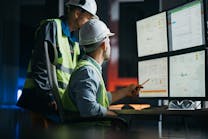The future of condition monitoring: AI-based asset health predictions
The industrial maintenance landscape has been undergoing a seismic shift for years, transitioning from traditional reactive maintenance to more proactive and predictive strategies. This evolution has been driven primarily by maintenance teams adopting cloud-based software and Industrial Internet of Things (IIoT) technologies. However, the changes emerging from artificial intelligence (AI) could be even more transformative.
That is why the companies working to embed today’s IIoT technologies into their maintenance practices are not merely adjusting to the present — they are preparing to lead in the future. In this article, we will discuss what the future condition monitoring looks like, and the challenges process manufacturers might face in the journey to get there.
From reactive to prescriptive
Predictive maintenance promises to move teams away from conventional reactive and calendar-based maintenance schedules to a more nuanced, condition-based approach. In short, predictive maintenance leverages the power of data analysis from various sensors to predict potential failures before they occur.
This predictive capability is not just about avoiding unplanned downtime; it is about reimagining how resources are allocated, enhancing equipment longevity and optimizing the operational efficiency of the entire manufacturing process. Using historical and real-time data can provide actionable insights, ensuring that maintenance efforts are precisely targeted and effectively implemented.
With the adoption of AI, teams can move beyond merely predicting potential issues. They can also receive prescribed maintenance recommendations that are finely tuned to the operational context of each asset. This evolution towards prescriptive maintenance is a testament to the sophistication of AI algorithms, which can sift through vast datasets to identify the most effective maintenance strategies based on past outcomes, operational peculiarities and even manufacturer specifications.
This nuanced approach ensures that maintenance activities are timely and contextually appropriate, maximizing their effectiveness and reducing the likelihood of unexpected failures.
Adopting AI software and services also means teams must utilize condition monitoring hardware to make such analysis possible. Condition monitoring platforms, especially wireless vibration sensors, serve as the backbone for real-time data collection and transmission, enabling a level of monitoring that was previously inconceivable. These technologies promise to help modern maintenance teams find solutions to many of the condition monitoring pain points that plague them today.
Navigating expertise constraints
Due to a shortage of expertise, maintenance knowledge that was once relatively common has become increasingly scarce in recent years. Fortunately, service providers, smart tools and cloud-based software can help expertise-constrained teams overcome the challenge.
AI can also help. Instead of having an in-house team of experts to analyze data, industrial AI solutions can fill the gap. Service providers can assist with developing and deploying advanced predictive maintenance systems with data analytics, machine learning and the requisite cybersecurity. Then, leadership can invest in the training and development programs needed to leverage these tools.
Through continuous learning, organizations should embrace a proactive approach to workforce development that ensures employees are equipped to harness the full potential of modern maintenance technologies.
As we look toward Industry 5.0, the significance of AI and IIoT in condition monitoring becomes even more pronounced. This next industrial era will be characterized by a focus on customization, sustainability and enhanced human-machine collaboration that unlocks insights from advanced condition monitoring systems. Together, humans and AI can help ensure maintenance teams meet operational efficiency goals.
Early adopters who integrate these technologies into their maintenance practices today will be more competitive in the future landscape of industrial manufacturing.
Addressing labor shortages
The industrial sector has also been among the hardest hit by labor shortages, thanks mainly due to an aging workforce and a new generation put off by traditional maintenance work's traditionally often manual, labor-intensive nature.
AI analysis and condition monitoring tools can help mitigate these labor challenges by improving efficiency and enabling automation. By predicting maintenance needs and optimizing schedules, these technologies can reduce the demand for constant manual oversight, allowing a leaner workforce to focus on higher-value tasks.
Additionally, implementing AI-driven systems can make the field more attractive to emerging talent, who may be drawn to the technological sophistication and strategic importance of modern maintenance roles.
Despite the significant advancements in AI and predictive analytics, human expertise remains crucial. Leadership must carefully consider how the integration of AI-based condition monitoring can augment the capabilities of maintenance professionals rather than replace them.
By providing maintenance teams with AI-generated insights and predictions, companies can leverage their technicians' nuanced understanding and experience to make more informed decisions. This symbiotic relationship between human intuition and machine intelligence could be a key driver in realizing the full potential of predictive maintenance. That will help maintenance teams ensure their actions are timely and executed with a level of expertise that AI alone cannot replicate.
Regulatory compliance and enhanced sustainability
The link between equipment reliability and sustainability is increasingly important as industries seek to minimize their environmental impact. Predictive maintenance not only extends the lifespan of equipment, but also ensures it operates at peak efficiency, minimizing unnecessary energy use and emissions.
As industries move toward more advanced maintenance strategies, they must also contend with an evolving landscape of regulations aimed at ensuring safety, reliability and environmental protection — and that is often not easy.
In industries like oil and gas, condition monitoring commonly takes place in hazardous environments. That means that vibration sensors and handheld tools must meet strict safety standards. In life sciences, new technologies cannot be introduced unless they can comply with FDA regulations. And, in highly competitive industries, companies do not always want condition monitoring data uploaded to the cloud.
Of course, elsewhere, regulatory bodies are helping push the adoption of predictive maintenance practices to ensure maintenance teams operate safely and efficiently. For example, food and beverage processors are pushed to conduct regular vibration monitoring to ensure their ammonia refrigeration equipment is not at risk of leaking.
Preparing for the future of AI-based condition monitoring
Despite the promising outlook, the journey towards fully realizing the potential of AI-based condition monitoring is fraught with challenges. These include concerns over data privacy, the need for a skilled workforce capable of interpreting AI-driven insights and the imperative to stay abreast of rapidly evolving technologies.
However, the opportunities presented by these advancements — ranging from enhanced operational efficiency to significant cost savings and reduced environmental impact — far outweigh the potential obstacles. The companies that embrace the transformative power and navigate these challenges effectively will not only thrive in the changing industrial landscape, but also play a crucial role in shaping the future of maintenance.
The revolution in condition monitoring is well underway, and it promises to transform maintenance from a routine task into a strategic asset. This will pave the way for a future where industrial operations are both more efficient and more aligned with the evolving demands of the global economy.
As director of product management at Fluke Reliability, Michael DeMaria leads the team responsible for overseeing hardware platforms, integrations, diagnostic software, AI tools, and user portal deliverables and business metrics. With over three decades of experience in vibration analysis, his expertise is rooted in his background in Navy nuclear engineering.


